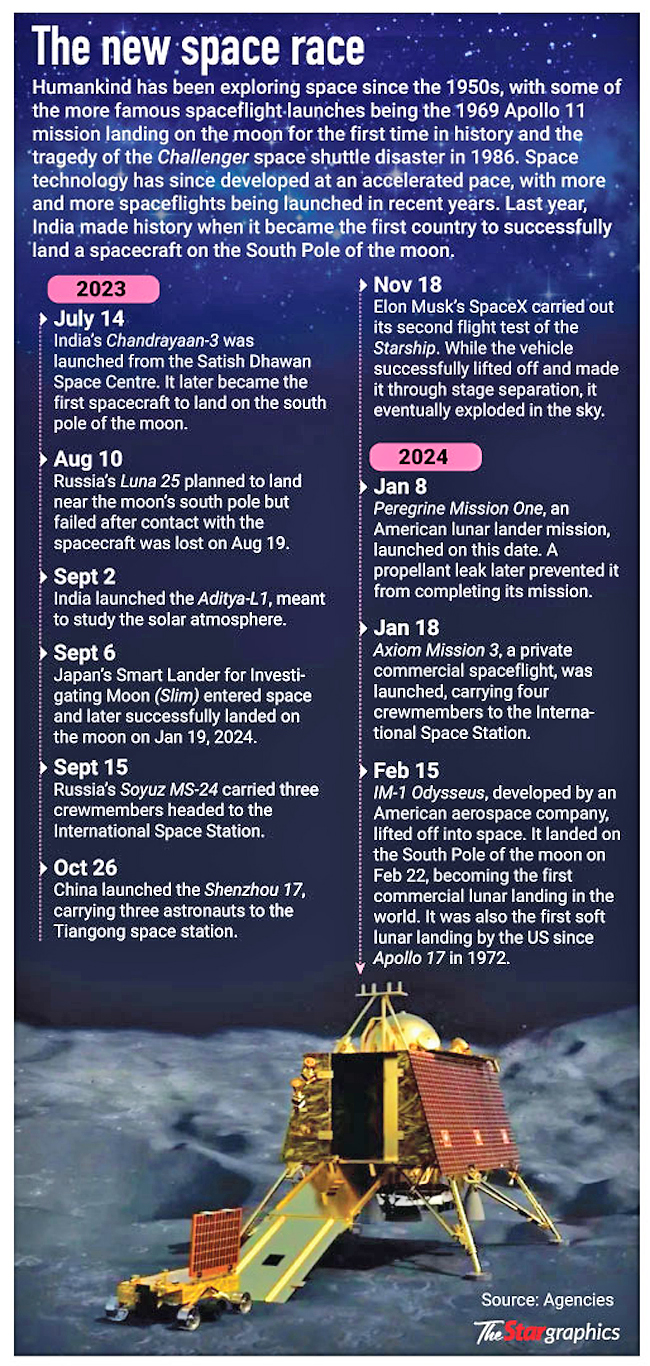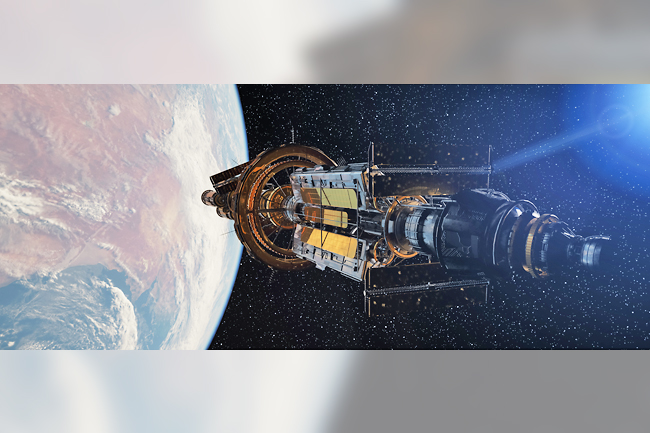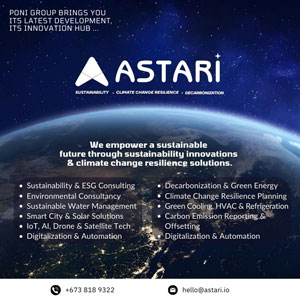ANN/THE STAR – Forget about the Cold War space race of the 20th Century – the new space age is here.
While superpowers like the United States and Russia once jostled for lunar dominance, a new generation of players are joining what is now a global space race – and Malaysia wants to be part of the equation too.
The country’s most high-profile space achievement was sending its first astronaut, Dr Sheikh Muszaphar Shukor, into space in 2007 but there have many quieter milestones from even before then, such as the development and launching of 12 satellites since 1996.
Among the country’s space capabilities now are space technology infrastructure such as satellite assembly and testing facilities, ground stations for mission control and satellite data reception, astronomical observatories, and the development of space-based applications for user agencies.
But that is not enough, as Science, Technology and Innovation Minister Chang Lih Kang said the country is currently undertaking various initiatives to further propel Malaysia’s standing as a competitive space hub in the eyes of the world.
The space industry has become a gold mine in recent years, with its global value standing at USD546 billion (MYR2.6 trillion) in 2022 while the local aerospace industry garnered an estimated revenue of MYR16 billion as of the third quarter of 2023.
Experts have also projected that the space industry will become a trillion-dollar industry by 2040.
Recognising the vast benefits a well-developed space industry can bring the nation, Chang said, Malaysia wants to have a finger in all the industry’s pies.



CHARTING A ROUTE INTO THE COSMOS
Among the things the government has done to this end are holding bilateral and multilateral discussions with space-faring countries such as Italy, Scotland, Turkiye and the United Arab Emirates to further strengthen collaboration in the space sector.
Malaysia has also signed a memorandum of understanding with the China National Space Administration to pursue bilateral scientific and technological exchanges and cooperation.
Similarly, a memorandum of cooperation between the Malaysian Space Agency (Mysa) and its Japanese counterpart was also signed last December.
Malaysia has also initiated a programme to establish a research and development hub in space policy and space law to increase collaboration in research and development, among others.
“Realising that consolidated effort is essential in promoting and supporting responsible space activities, Malaysia is extending the initiative to ASEAN to offer space law capacity – building and legal advisory services for regulatory authorities of new and emerging spacefaring nations in the region,” Chang said.
Closer to home, the ministry has developed the National Space Policy 2030 that covers space technology, infrastructure and applications in the areas of navigation, communication and remote sensing.
TERRESTRIAL AND BEYOND
Many people are unaware that space technology has multiple terrestrial applications that affect their daily lives.
For example, maps that used to be on paper only can now be accessed in real-time via GPS to navigate the roads globally.
As such, Malaysia must remain abreast of space technology developments that can better the lives of the people.
Aside from that, Chang said Malaysia wants to develop a sustainable national space sector ecosystem as it is expected to contribute at least RM10bil to the country’s gross domestic product (GDP) and create up to 5,000 new job opportunities.
However, Deputy Vice-Chancellor (Industry and Community Relations) at Universiti Putra Malaysia Prof Renuganth Varatharajoo, an expert in aerospace engineering, pointed out that the global space race extends beyond terrestrial application.
“It covers interplanetary exploration that requires a huge investment. The global space race is driven by the quest for new space and materials, such as energy materials, whereas our National Space Policy covers only the affordable and relevant space applications.”
Since the National Space Policy focuses on terrestrial applications of space technology, he said Malaysia can have a more focused space solution such as a domestic precise remote navigation solutions which can then be extended or sold to other developing countries.
“Space technology is the pinnacle of an advanced nation. Therefore, the space quest is inevitable for developing nations as well,” Professor Renuganth said.
READY, SET, LIFTOFF
The National Space Policy is not meant to limit Malaysia’s foray into the global space race to just terrestrial applications.
One of the next things on Malaysia’s space agenda is establishing a space launch site in the country.
The Sabah state government is especially interested in this.
Last June, Sabah signed a memorandum of understanding with a Ukrainian firm and a local company to study the feasibility of a space launch facility in the state.
The results of this study will be submitted to Mysa for further evaluation.
Professor Renuganth said Sabah would be a good launching site as it is near the open sea towards the east and it is also near the equator.
However, he suggests the government should look into using such a port for space suborbital tourism, rather than entering the highly competitive space launch segment which requires a huge investment.
Meanwhile, Chang said aside from the one in Sabah, several local companies have shown interest in developing launch facilities in Malaysia through strategic local and international cooperation.
To ensure the smooth sailing of any such endeavours, he says the National Space Committee endorsed the Feasibility Study Guideline for the Development of Launching Facilities in Malaysia last November.
“The main objective of this document is to be the reference for entities that are interested in carrying out the feasibility study, and at the same time avoid any gaps or overlap with current regulations and acts that are taking effect.
“The guideline is applicable and can be used by all parties who intend to develop a launch facility in Malaysia,” Chang said.
SPACE-AGE WORKFORCE
There are already more than 60 local companies involved in the space industry in Malaysia, he added.
But with 5,000 new jobs expected to be created in Malaysia’s space sector, there is a need to find skilled workers to fill those positions, whether locally or from abroad.
The space industry is a global, borderless field, said Professor Renuganth. “Therefore, it is natural to attract foreign experts to grow our local space technology rapidly. It’s a quick fix to bridge the technological gap too.”
In the long term, Chang said many universities in Malaysia are currently offering space science and technology-related courses.
Part of the National Space Policy’s aim is also to initiate and implement an expert development programme that will produce 120 experts in space science, technology and applications by 2030, he said.
“Thus, the government is confident that with the collaborative efforts of all stakeholders, especially government agencies, industry, academia and non-governmental organisations, Malaysia will be able to build local expertise and develop the ability of the local space industry to be competitive and strengthen international cooperation,” he said. – Geraldine Tong







